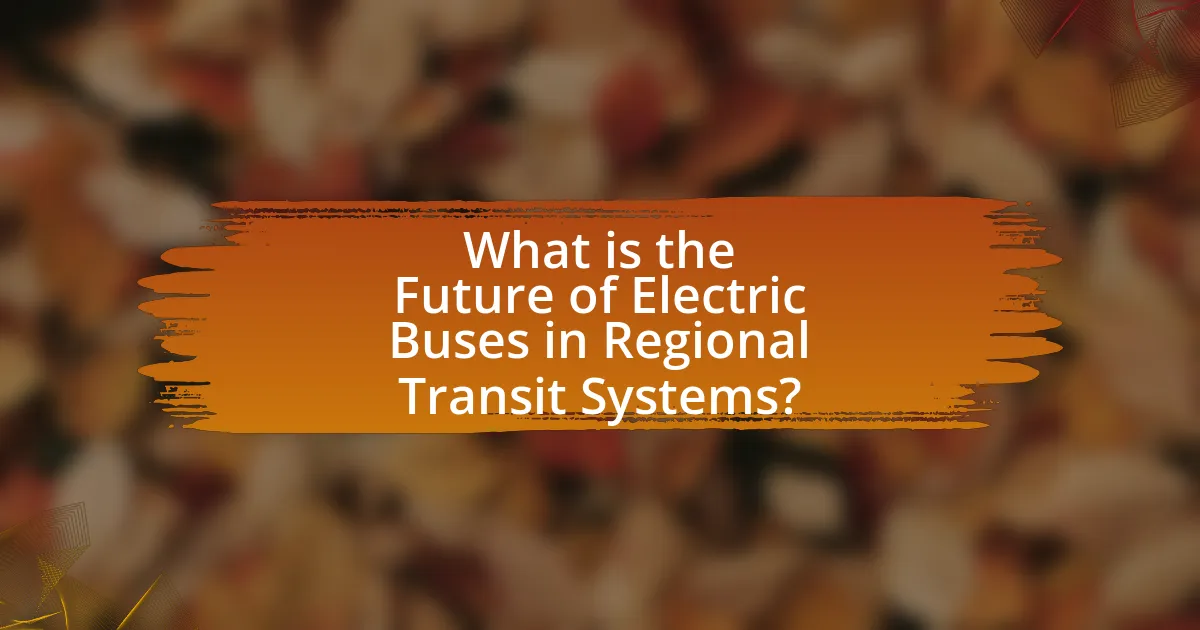The article focuses on the future of electric buses in regional transit systems, highlighting their potential for growth due to technological advancements, environmental policies, and urban planning initiatives. It outlines the definition of electric buses as zero-emission vehicles, their operational and environmental benefits, and the technologies that enhance their performance. The article also addresses the challenges faced by transit systems in adopting electric buses, including high upfront costs and infrastructure needs, while emphasizing the importance of government support and strategic planning for successful integration. Key trends, best practices, and strategies for public education regarding electric buses are also discussed, providing a comprehensive overview of the transition towards sustainable public transportation solutions.

What is the Future of Electric Buses in Regional Transit Systems?
The future of electric buses in regional transit systems is poised for significant growth and transformation, driven by advancements in technology, environmental policies, and urban planning initiatives. As of 2023, many regional transit authorities are increasingly adopting electric buses to reduce greenhouse gas emissions and improve air quality; for instance, the American Public Transportation Association reported that electric bus adoption could lead to a 70% reduction in emissions compared to diesel buses. Furthermore, the decreasing costs of battery technology and increased range capabilities are making electric buses more viable for longer routes, enhancing their appeal for regional transit systems. Additionally, government incentives and funding programs, such as those from the Federal Transit Administration, are further supporting the transition to electric fleets, indicating a strong commitment to sustainable public transportation solutions.
How are electric buses defined within regional transit systems?
Electric buses are defined within regional transit systems as zero-emission vehicles designed to operate on fixed routes, utilizing electric power for propulsion. These buses contribute to reducing greenhouse gas emissions and improving air quality in urban areas. According to the American Public Transportation Association, electric buses can significantly lower operational costs due to reduced fuel and maintenance expenses compared to traditional diesel buses. Additionally, many regional transit systems are adopting electric buses as part of their sustainability goals, with cities like Los Angeles and Seattle leading the way in integrating these vehicles into their fleets.
What technologies are involved in electric bus systems?
Electric bus systems utilize several key technologies, including electric drivetrains, battery energy storage systems, regenerative braking, and advanced charging infrastructure. Electric drivetrains replace traditional internal combustion engines, providing efficient propulsion powered by electric motors. Battery energy storage systems, typically lithium-ion batteries, store electrical energy for operation, with capacities ranging from 100 kWh to over 600 kWh, enabling longer ranges and reduced charging times. Regenerative braking technology captures energy during braking and feeds it back into the battery, enhancing overall efficiency. Advanced charging infrastructure, such as fast chargers and wireless charging systems, supports rapid recharging and operational flexibility, facilitating the integration of electric buses into existing transit networks. These technologies collectively contribute to the sustainability and efficiency of electric bus systems, aligning with global efforts to reduce emissions in public transportation.
How do electric buses differ from traditional buses?
Electric buses differ from traditional buses primarily in their power source; electric buses operate on electric energy stored in batteries, while traditional buses typically rely on diesel or gasoline engines. This fundamental difference leads to several key distinctions: electric buses produce zero tailpipe emissions, contributing to improved air quality, whereas traditional buses emit greenhouse gases and pollutants. Additionally, electric buses often have lower operating costs due to reduced fuel expenses and maintenance needs, as electric drivetrains have fewer moving parts compared to internal combustion engines. According to the American Public Transportation Association, electric buses can reduce energy costs by up to 70% compared to diesel buses, highlighting their economic advantages.
Why is the transition to electric buses important for regional transit?
The transition to electric buses is important for regional transit because it significantly reduces greenhouse gas emissions and improves air quality. Electric buses produce zero tailpipe emissions, which contributes to cleaner urban environments and aligns with global efforts to combat climate change. According to the American Public Transportation Association, transitioning to electric buses can reduce emissions by up to 80% compared to diesel buses. Additionally, electric buses can lower operational costs due to reduced fuel and maintenance expenses, making them a financially viable option for regional transit authorities.
What environmental benefits do electric buses provide?
Electric buses provide significant environmental benefits, primarily by reducing greenhouse gas emissions and improving air quality. Unlike diesel buses, electric buses produce zero tailpipe emissions, which directly contributes to lower levels of harmful pollutants such as nitrogen oxides and particulate matter in urban areas. According to a study by the Union of Concerned Scientists, electric buses can reduce greenhouse gas emissions by up to 70% compared to their diesel counterparts, depending on the electricity source. Additionally, the transition to electric buses supports the shift towards renewable energy, further enhancing their positive environmental impact.
How do electric buses impact operational costs for transit systems?
Electric buses significantly reduce operational costs for transit systems primarily through lower fuel and maintenance expenses. The cost of electricity for charging electric buses is generally lower than diesel fuel, leading to savings; for instance, electric buses can cost about $0.15 per mile compared to $0.40 per mile for diesel buses. Additionally, electric buses have fewer moving parts, resulting in reduced maintenance costs, which can be up to 30% lower than their diesel counterparts. These factors contribute to overall savings in operational budgets, making electric buses a financially viable option for transit systems.
What challenges do regional transit systems face in adopting electric buses?
Regional transit systems face significant challenges in adopting electric buses, primarily due to high upfront costs, limited charging infrastructure, and range anxiety. The initial investment for electric buses is often substantially higher than for traditional diesel buses, which can deter transit agencies from making the switch. Additionally, the lack of adequate charging stations can hinder the operational feasibility of electric buses, as they require reliable access to charging facilities to maintain service schedules. Range anxiety, or the fear that electric buses will not have sufficient battery life to complete their routes, further complicates adoption, especially in regions with longer transit routes. These challenges are supported by data indicating that while electric buses can reduce operational costs over time, the initial financial and infrastructural barriers remain significant obstacles for many regional transit systems.
What infrastructure is needed to support electric buses?
Electric buses require a robust infrastructure that includes charging stations, maintenance facilities, and dedicated bus lanes. Charging stations must be strategically located to ensure that buses can recharge efficiently during their routes, with fast-charging capabilities to minimize downtime. Maintenance facilities need specialized equipment and trained personnel to handle the unique requirements of electric bus technology, including battery management and electric drivetrains. Additionally, dedicated bus lanes can enhance operational efficiency and reduce travel times, making electric buses a more attractive option for public transit. According to the American Public Transportation Association, investing in this infrastructure is crucial for the successful integration of electric buses into regional transit systems.
How do funding and policy affect the adoption of electric buses?
Funding and policy significantly influence the adoption of electric buses by providing financial resources and regulatory frameworks that facilitate their integration into transit systems. For instance, government grants and subsidies lower the upfront costs for transit agencies, making electric buses more financially viable. According to the American Public Transportation Association, federal funding programs have allocated billions to support the purchase of electric buses, which directly impacts the number of electric buses deployed in various regions. Additionally, policies that mandate emissions reductions or set targets for zero-emission vehicles encourage transit agencies to transition to electric fleets, as seen in California’s Innovative Clean Transit regulation, which requires all public transit agencies to transition to zero-emission buses by 2040. These funding mechanisms and policy directives create a conducive environment for the widespread adoption of electric buses in regional transit systems.
How can regional transit systems effectively implement electric buses?
Regional transit systems can effectively implement electric buses by developing a comprehensive infrastructure that includes charging stations, maintenance facilities, and route planning tailored to electric vehicle capabilities. This approach ensures that electric buses can operate efficiently and reliably within the existing transit framework. For instance, cities like Los Angeles have successfully integrated electric buses by establishing dedicated charging infrastructure and optimizing routes to accommodate the buses’ range limitations, demonstrating that strategic planning and investment in infrastructure are crucial for successful implementation.
What are the key trends shaping the future of electric buses?
Key trends shaping the future of electric buses include advancements in battery technology, increased government support, and the integration of smart technologies. Advancements in battery technology, such as solid-state batteries, enhance energy density and reduce charging times, making electric buses more efficient and practical for transit systems. Increased government support is evident through subsidies and incentives aimed at promoting electric vehicle adoption, with countries like the United States and China investing billions in electric bus infrastructure. Additionally, the integration of smart technologies, including real-time data analytics and vehicle-to-grid systems, optimizes operational efficiency and enhances user experience, as seen in cities like Los Angeles and Shenzhen, which have successfully implemented electric bus fleets.
How is technology evolving to enhance electric bus performance?
Technology is evolving to enhance electric bus performance through advancements in battery technology, energy management systems, and vehicle design. Innovations such as solid-state batteries are increasing energy density and reducing charging times, which allows electric buses to travel longer distances on a single charge. Additionally, smart energy management systems optimize energy consumption by adjusting power distribution based on real-time data, improving overall efficiency. For instance, the integration of regenerative braking systems recovers energy during deceleration, further extending the range of electric buses. These developments are supported by research indicating that electric buses can achieve up to 80% energy efficiency compared to traditional diesel buses, which typically operate at around 20-30% efficiency.
What role do partnerships play in the expansion of electric bus fleets?
Partnerships are crucial for the expansion of electric bus fleets as they facilitate resource sharing, technology transfer, and funding opportunities. Collaborations between public transit agencies, private companies, and governmental bodies enable the pooling of expertise and financial resources, which accelerates the deployment of electric buses. For instance, partnerships can lead to joint investments in charging infrastructure, reducing the overall costs and risks associated with transitioning to electric fleets. Additionally, successful examples such as the collaboration between the Los Angeles Department of Transportation and various technology firms demonstrate how partnerships can enhance operational efficiency and promote sustainable practices in public transportation.
What are the best practices for integrating electric buses into existing transit systems?
The best practices for integrating electric buses into existing transit systems include conducting thorough route assessments, investing in charging infrastructure, and ensuring staff training. Route assessments help identify the most suitable routes for electric buses based on factors like distance, passenger demand, and charging needs. Investing in adequate charging infrastructure, such as fast chargers at depots and on-route charging stations, is essential to maintain operational efficiency. Additionally, training staff on the unique operational characteristics of electric buses ensures effective maintenance and service delivery. These practices are supported by successful implementations in cities like Los Angeles and Shenzhen, which have demonstrated significant reductions in emissions and operational costs through strategic integration of electric buses.
How can transit agencies ensure a smooth transition to electric buses?
Transit agencies can ensure a smooth transition to electric buses by implementing comprehensive planning and infrastructure development. This includes assessing current fleet needs, investing in charging infrastructure, and training personnel on electric bus operations. For instance, a study by the American Public Transportation Association indicates that agencies that develop a phased implementation plan, which includes pilot programs and stakeholder engagement, experience fewer operational disruptions. Additionally, securing funding through federal grants and partnerships can facilitate the acquisition of electric buses and necessary technology, further supporting a seamless transition.
What strategies can be employed to educate the public about electric buses?
To educate the public about electric buses, strategies such as community engagement programs, informational campaigns, and hands-on demonstrations can be employed. Community engagement programs involve organizing local events where residents can learn about the benefits and technology of electric buses directly from transit authorities and experts. Informational campaigns can utilize social media, local news outlets, and public service announcements to disseminate facts about electric buses, including their environmental benefits and cost savings. Hands-on demonstrations allow the public to experience electric buses firsthand, fostering familiarity and acceptance. Research indicates that communities with active outreach programs see a higher acceptance rate of electric vehicles, as evidenced by a study from the International Council on Clean Transportation, which found that public awareness significantly influences adoption rates.
What practical tips can regional transit systems follow for successful electric bus deployment?
Regional transit systems can ensure successful electric bus deployment by conducting thorough route analysis to identify optimal service areas, investing in adequate charging infrastructure, and providing comprehensive training for operators and maintenance staff. Route analysis helps in determining the most efficient paths for electric buses, ensuring they can operate within their range limits. Adequate charging infrastructure, including fast chargers at depots and strategically located charging stations, is essential for minimizing downtime and maximizing operational efficiency. Training for operators and maintenance staff is crucial to address the unique aspects of electric bus technology, ensuring safety and reliability in service. These strategies are supported by successful implementations in cities like Los Angeles and Seattle, which have seen significant improvements in operational efficiency and reductions in emissions through effective electric bus deployment.


